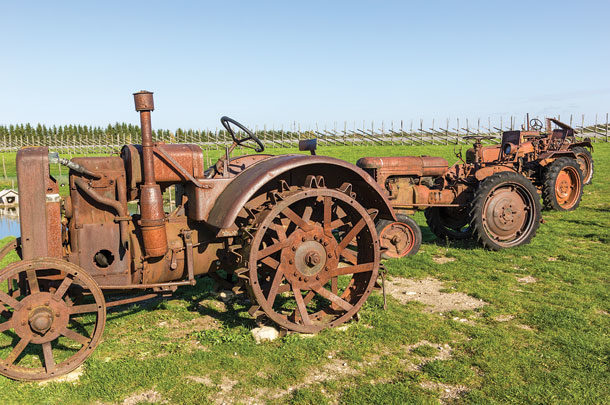I have four harvests left to get things chucked, sorted and packed for a new home.
What might sound daunting to some to others is a great relief – to have a target date to make changes. Michelle Wright (of Wide Open Spaces) has crafted a niche business of “heirloom rescuing” and “money wrangling,” helping farmers in northeastern Alberta make the transition to a new lifestyle.
Here are Wright’s tips:
-
Get started by focusing on the farm piece. In our case, the farm is staying in the family, just new faces in the yard. For farmers who are vacating and selling, they have more layers of issues – finances, organization and making transitional plans.
Wright has a background in stakeholder relations in the oil patch, so she uses those skills to help people focus on one piece of the move at a time.
-
List out the many things that you want to accomplish. Wright works at the kitchen table and builds relationships with the landowners.
She can remove firearms since she has her firearms safety certificate. She is on a first-name basis with the landfill operators and is trained to remove hazardous materials and dangerous goods.
She knows the correct disposal method for a lot of stuff and has property cleanup specialists who can clear up loads of steel and iron and take it away. Their fee is usually the value of the load on the trailer.
-
Know your social service network. Many adult children live far away from the home farm that is up for sale, and they don’t want to be driving or flying “home” every weekend of their precious summer to be dealing with all of Mom and Dad’s possessions (aka junk).
Wright lines up social service connections and food banks locally who can benefit from the household effects.
-
Have realistic expectations. Farmers rarely move. Over the course of 40 to 60 years, they can accumulate a pile of stuff. You’ve probably watched the picker shows on TV where guys hunt for treasure – but you don’t have time for this.
Wright feels you need 18 months to downsize. She coaches her families gently over and over again, saying, “Let go.” Letting go is a coaching strategy.
You need to be able to let go of things so you can create new space for a new chapter in your life. Wright is careful to ask, “Where are your treasures?” and learns the story about the objects. When the clients say, “I am not ready to let go,” then Wright asks, “What are you ready for?”
-
Get another perspective on your stuff. Wright has downsized a grain bin full of used washing machines. The objection from the hoarder was, “If something breaks, I might need a part.”
Imagine all of the generations of stuff in layers in the farmhouse basement. Give treasures to grandkids and share the story of that treasure while you are alive.
As a home economist who enjoys practical re-purposing of found objects, I am drawn to de-cluttering articles and books. The hot one on the market these days which I have read is The Life-Changing Magic of Tidying up: The Japanese Art of Decluttering and Organizing by Marie Kondo.
Kondo starts with clothes first by discarding all at once, intensely and completely. I know that when my aunt died, my uncle could not move a thing, even five years later when it was his turn to move to a new home. Do your family a favour by making large donations to the local thrift store.
Have a picture on the fridge of your new home or ideal new location. A vision of what you are moving toward can inspire you to keep throwing away or giving away the pieces of your old life chapter you don’t need to carry along.
My mother-in-law set up an 8-foot table that was the free zone, and each time she had visitors, they had to scan the table for treasures to take home with them. Her large book collection was a great gift to life-long learners who appreciated her generosity.
Keeping up the energy for sorting, tossing and giving is hard. That is why we have offered to help elderly women in our community. You could do this in your rural community to help people move on.
Don Aslett, author of Clutter’s Last Stand, says we keep too much evidence junk, like old university papers or textbooks. I donated old trophies to the local school to repurpose. It takes time and effort to give things away.
Kondo suggests that “during the selection process, if you come across something that does not spark joy but that you just can’t bring yourself to throw away, stop for a moment and ask yourself, ‘Am I having trouble getting rid of this because of an attachment to the past or because of a fear for the future?’”
Our ownership patterns reflect what we value. My sister is a minimalist and when she moves, I, the older sister, get a lot of furniture, pillows and mirrors she no longer cares about. Why does my house become the holding tank for deceased relatives’ possessions and my sister’s former things?
Borrow Kondo’s book from your library and be inspired to start downsizing. Leaving a tidy estate is a great gift to your heirs. Taking the things with you that bring joy will bless your new home in town and give you a fresh start for the next chapter beyond the farm.
Let me know how it goes. I need tips and action to get stuff sorted. Four years is going to fly by, and my daughter in-law will appreciate a clean slate in 2020. PD
PHOTO: Photo courtesy of ThinkStock.

-
Elaine Froese
- Business Coach
- Farm Family
- Email Elaine Froese








